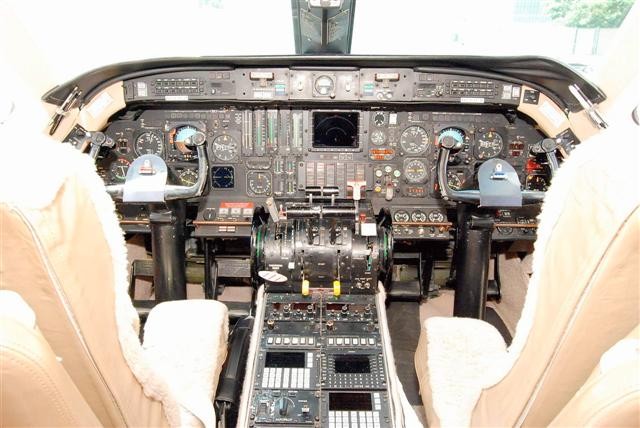


Aircraft Description
Background/History
The Grumman Gulfstream G-II was introduced in 1967 as the first transcontinental-range business jet with a true stand-up cabin. In 1976 Grumman announced that it was developing a successor to the Gulfstream II, but canceled the program in May 1977, when it was decided that the new aircraft could not be made available at an acceptable cost. Grumman subsequently sold its American division to Allen Paulson, and in 1978 the G-III was announced. The new aircraft featured a fuselage stretch of 4 ft., a wrap-around windshield, and a new wing incorporating a 10% increase in span as well as the new Whitcomb winglets. The improved wing made possible a significant reduction in fuel burn, and the increased fuel capacity allowed for an improvement in range without the need for tip tanks. The G-III was replaced by the G-IV in 1986 after a production run of 202 units.
Power
The Gulfstream G-III is powered by a pair of Rolls-Royce Spey Mk 511-8 tubofans rated at 11,400 lbs. thrust each. Inspection interval on the engines is 8,000 hours.
Avionics
A typical installation for the Gulfstream G-III includes the Sperry SPZ 800 flight director system, 4-tube EFIS, triple Collins VHF 20 comms, dual Collins VIR 31 navs, dual DME 860, dual TDR 94 transponders, dual Honeywell laser INS, dual ADF, Collins HF 628 high freq comm, Global GNS 1000 FMS, and Sperry Primus 800 color weather radar. Pro Line 21 Continuum for the Gulfstream III includes a number of systems and products that will improve operational efficiency and enhance aircraft value. The Collins FDS-2000 Flight Display System supports such advanced capabilities as terrain awareness, FMS navigation maps, controller-pilot data link, and TCAS II and turbulence-detection weather radar.
Design Features
The Gulfstream G-III is configured as a cantilever low swept-wing monoplane with cantilever T-tail. The retractable tricycle landing gear has dual wheels on each unit. The wing is redesigned as compared to that of the G-II and incorporates drag-reducing Whitcomb winglets. The new wing results in a decrease in fuel consumption of approximately 18% as reported by Gulfstream. The G-III incorporates a fuselage stretch of four feet resulting in a total cabin length of over 41ft.
Accomodations
The Gulfstream G-III is a true stand-up cabin, wide-body business jet designed to accomodate its passengers in comfort during transcontinental flights. Seating configurations vary widely, but a typical corporate layout can seat 8 to 12 passengers in club combination arrangements. As many as 21 passengers can be seated in a high density configuration. Typical cabin ammenities include a full-sized lavatory and deluxe refreshment center with refrigerator and coffee maker. The G-III’s cabin height is 6.1 ft., cabin width is 7.3 ft., and cabin length is 41.4 ft., with total cabin volume of 1,502 cu. ft.
| General | G-III, G-1159A | |||
|---|---|---|---|---|
| Category | Jet < 20,000 lbs. | |||
| Years Aircraft Manufactured | 1979 – 1987 | |||
| Serial Number Range | 249 – 498, 875 | |||
| Retail High Price | $4,995,000.00 / 3,919,576.50€ | |||
| Retail Low Price | $575,000.00 / 451,202.50€ | |||
| Characteristics | G-III, G-1159A | |||
| Seating | 2+14/19 | |||
| Wing Loading | 74.5 | |||
| Power Loading | 3.0 | |||
| Noise(EPNdB): Takeoff/Sideline/Approach | 91.1/97.3 | |||
| External Dimensions (ft) | G-III, G-1159A | |||
| External Length | 83.1 | |||
| External Height | 24.3 | |||
| External Span | 77.8 | |||
| Internal Dimensions (ft) | G-III, G-1159A | |||
| Internal Length (Overall/Net Height) | 41.3 | |||
| Internal Height | 6.1 | |||
| Internal Width (Max/Floor) | 7.3 | |||
| Baggage | G-III, G-1159A | |||
| External: Cu.Ft./Lb. | N/A | |||
| External: Cu.Ft./Lb. | N/A | |||
| Power | G-III, G-1159A | |||
| Engines | 2 RR Spey Mk 511-8 | |||
| Output (lbs ea.)/Flat Rating | 11,400 | |||
| Inspection Interval | 8,000t | |||
| Data based on latest manufactured year | ||||



